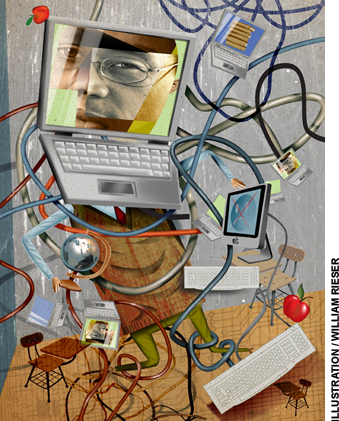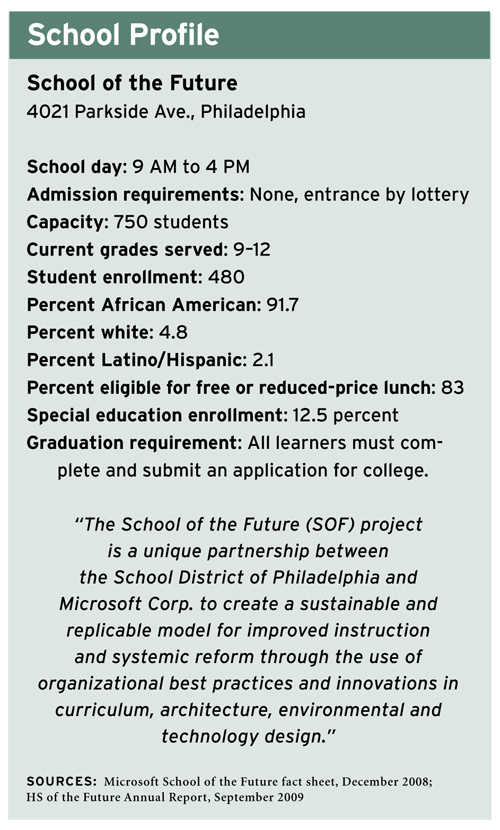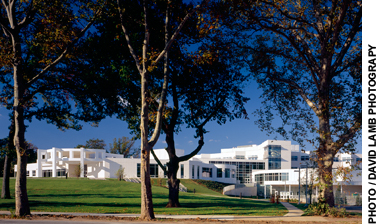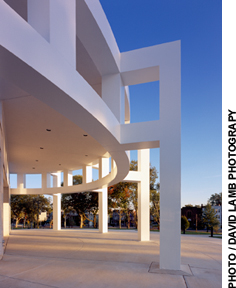 In 2003, leaders at the School District of Philadelphia, district CEO Paul Vallas and chairman of the School Reform Commission James Nevels, enlisted the help of the Microsoft Corporation in a bold effort: reshape the archaic 19th-century high school model to better prepare students, especially urban students, to live and work in the 21st. Three years later, they opened a sleek, eco-friendly, technologically advanced $62 million building in west Philadelphia bounded by a vast urban park, the city’s historic zoo, and some of the most blighted streets in the city. It was called School of the Future (SOF).
In 2003, leaders at the School District of Philadelphia, district CEO Paul Vallas and chairman of the School Reform Commission James Nevels, enlisted the help of the Microsoft Corporation in a bold effort: reshape the archaic 19th-century high school model to better prepare students, especially urban students, to live and work in the 21st. Three years later, they opened a sleek, eco-friendly, technologically advanced $62 million building in west Philadelphia bounded by a vast urban park, the city’s historic zoo, and some of the most blighted streets in the city. It was called School of the Future (SOF).
Here, it was forecast, nothing less than the transformation of American secondary education would take place. This would be a neighborhood school, in the heart of impoverished urban America, committed to educating all students, not to weeding out the most challenging. Technology would bring the students to new heights, and serve as a prototype for reform and innovation elsewhere.
Each student—or “learner”—would have a laptop or tablet computer. The course of study would be dynamic, interdisciplinary, and driven by their interests. The teachers, called educators, and the community would collaboratively develop a “continuous, relevant, and adaptive” curriculum. Learning would spill out of the building into the surrounding neighborhood and, virtually, across the world.
The September 2006 opening of the school, thick with dignitaries, was featured on the national morning talk shows. Politicians jostled to get their faces in the picture during the ribbon cutting. Vallas declared the dawn of a new educational era. “This is how schools of today can and should be designed and developed to adequately prepare students for life and work,” he said.
Parents and students, who were chosen by lottery, exclaimed in wonder as they walked through the glass doors for the first time. Among them were Carmen Thomas and her son Sekou Thomas-Bamba. Thomas could barely contain her elation.
“This is just absolutely amazing,” she said, according to an account the next day in the Philadelphia Inquirer. “It’s like a fresh start, new dreams, new adventure, hope. For him to walk in and be a part of the first graduating class is exciting.”
Full of enthusiasm, Thomas said that she would volunteer at the school and learn the technology herself.
Fast-forward to the fall of 2009. On a Thursday evening in October, Thomas had kept her promise to volunteer: she and her son were among a handful of parents and students who came to the school to help evaluate the graduation project proposals of the first senior class.
Did the school turn out to be everything she expected?
Thomas thinks for a minute. An adventure, certainly. But not in the way she had anticipated. “There have been challenges,” Thomas said. “The transition from books to learning from laptops—I’m not sure all the students were ready.”
Sekou, who had spent his elementary years in a highly structured religious school, described his freshman year as “out of control. No one knew what to do exactly.” Sophomore year, he considered transferring. “I felt I wasn’t learning enough,” he said.
To be sure, the future has not yet arrived at School of the Future. Its early years have been plagued by a crisis in leadership, a revolving door of principals and wavering support for its mission from the Philadelphia district. The school’s downtown champions, Vallas and Nevels, were gone soon after SOF opened its doors. Some of the more exciting plans for technology use, including a Virtual Teaching Assistant that would allow teachers to track individual student progress online, never materialized. Solar panels were designed to transmit real-time data on energy use so students could study it, but the equipment has yet to be installed. Despite the awe that the school generated in the community, it has not filled to capacity. Built for 750, enrollment is below 500 in its fourth year. Walk through classrooms today and what you will see, pedagogically, is not terribly different from what happens in any high school.
Mary Cullinane, who has directed the project for Microsoft since the beginning, acknowledges the difficulties but has few regrets. Today’s children, she said, deserve learning communities that are inspirational, not just functional. And she says that, despite the problems, the experience at SOF has been invaluable.
“We’ve learned that we have to prepare for a very long journey,” she said. “If we want to be disruptive and allow for education to have a different experience in the United States, we need to recognize the long-term nature of this work and stop using short-term yardsticks to measure progress.”
Cullinane adds, “I’m not sure anybody has the stomach for this…innovation swims upstream in the river of status quo.”
Developing SOF has been compared by more than one person to building an airplane while flying it. Those involved discovered that the default educational model—organized around bell schedules, teaching separate subjects in isolation, the assumption that most students learn the same material in the same way, the lockstep progression through grade levels, report cards with letter grades, and other conventions that most of America understands as “school”—does not give ground easily. Even the effort to start later in the morning, citing research that this is best for adolescents, ran up against bus schedules and the demand of after-school athletics.
The first two years of the school’s existence were marked by turmoil. The first principal, called “chief learner” at SOF, Shirley Grover, had a background in private schools, most recently in Italy, not in urban education. But her vision for change was bold and ambitious, her optimism boundless, and she was intensely recruited to help design the school and hire the first teachers. But she left, for personal reasons, in the summer after the first year.
After that, the school was run on an interim basis first by a retired principal who described himself as a seat warmer and then by an administrator who had no high school experience and didn’t quite get its mission.
Now in her second year as principal, Rosalind Chivis had a hand in the school’s start-up and spent several years in the district central office before being sent to rescue SOF. Always on the move, she presents a stern face to students and visitors alike. Students who arrive late or break the rules get little sympathy from her.
Shortly after taking over, Chivis cracked down on discipline and engineered the transfer of more than 60 problematic students, more than 10 percent of the student body, a move that some teachers equated to abandoning the mission of educating every child. “These were not all bad kids, they were kids who made bad choices,” lamented one.
Chivis doesn’t see it that way.
“When I came, I had to create a culture and climate conducive to effective teaching and learning,” she said. “I think we’re at a place now. I feel comfortable focusing attention on instruction.”
At the same time, Chivis wants SOF to blaze new trails and fulfill its original mission.
“We’re all in agreement we want an organization and a learning environment that is student-centered, we want instruction to be student-driven, we want it to be engaging, and we want there to be lots of opportunities for experiential learning, reflection, and inquiry,” she said.
Microsoft helped design and launch the school but, contrary to public perception, did not pay for it. The company deliberately tried to work within the resource and bureaucratic limits of the existing system, determined to create something that was scalable and replicable in other big school districts. So it declined to pull out all the stops in hiring staff, for instance, instead combining its intensive, competency-based hiring process with the rigid, centralized, and seniority-based system in Philadelphia. For the most part, school leaders, and later, committees led by teachers themselves, were able to choose the new staff members as the school added a grade a year.
But, with dual-subject certification required for all applicants to facilitate the interdisciplinary model, prospective teachers weren’t beating down the doors to work there. Especially after it began to gain a reputation as having problems, the school has had trouble filling all the teaching jobs.
Many of the mostly young educators who were lured by the promise that they could create something entirely new have felt stymied. They were drawn to SOF precisely because it was refusing to cream top students, but was instead ready to work with those who were dropping out in droves or would graduate with substandard knowledge and skills from traditional neighborhood schools.
“It was presented as a school, it still is a school, that is trying to ‘fix’ education,” said Aruna Arjunan, who came in the beginning and teaches social studies and math. “That sounds grandiose, but the whole point is to do things a different way.”
Yet this challenge proved greater than anyone had anticipated. The students, almost all African American, more than 80 percent of whom qualify for free or reduced-price lunch, came with skill levels all over the map; a majority read at a 5th-grade level or below. Used to worksheets, paper-and-pencil tests, and being asked to regurgitate information, many weren’t prepared to take control of their own learning. Some thrived on the project-based, interdisciplinary, and technology-rich model, and were finally able to connect to the purpose of school; others simply found it bewildering.
“I could only imagine what it was like for the learners when they first arrived in this building,” said Kathleen Lee, a veteran Philadelphia teacher whose longtime interest in project-based learning brought her to SOF. “Everything’s online for you. Your math’s online. Your writing’s online. Your foreign language is online. They were never taught like that. They needed gradually to be eased into this.”
The technology itself created problems for managing the classroom. “I would spend 30 or 60 minutes of a period deleting games from the computer,” lamented one teacher. Students would be instant messaging and checking emails during class. “When you’re exhausted because you’ve been telling kids to stop playing Halo all day, you’re not actually teaching them literature or skills or the content that they need to drive their own learning.”
Several people involved have gone so far as to say that there has been a culture clash between the design and expectations of the school and the learners’ readiness to take advantage of it.
“The leadership when we opened the building went into this with certain assumptions, and they were that the children…were coming already motivated to learn and were at a certain skill level. That was not the case,” said Chivis. “Had more thought been put into where these learners were coming from and what they were coming with, we may have realized a greater degree of success.”
Balancing Act
Any way you look at it, developing the curriculum for School of the Future has been a roller-coaster ride. Wrote one young SOF teacher, “Programs begun one year vanished the second; systems implemented one minute were overhauled the next. And thus, like the demoralized Biblical man who builds his home on a foundation of sand only to see it fall, any sense of agency our learners had [developed] disappeared as their expectations for the future collapsed.”
There was no set curriculum in the first year: “Educators wrote their own curriculum,” said one member of the original faculty. “It was project-based, mission- and vision-driven.” Working in teams, they devised projects with the help of a web exchange called Understanding by Design, which provides materials and helps educators develop interdisciplinary, project-based units that meet the subject-matter standards in a specific state. Teachers team taught, there was no defined bell schedule, and at the end of the day, it was hard to quantify what the students had learned, a mortal sin in today’s accountability climate.
Educators spent the second year designing an interdisciplinary project system with levels 100 through 400, similar to college courses. Students were assigned based on their skill levels and progressed at their own pace. Many educators were proud of this, but it had some of the same problems as the first year, primarily an inability to be “transparent” to the standardized test–based accountability system in use by the school district.
For starters, the school district’s computer couldn’t accept SOF’s narrative-style report cards, which evaluated students’ proficiency in the core competencies rather than giving them traditional numeric grades in individual subjects. District officials were concerned that students couldn’t easily transfer from a school with this sort of interdisciplinary structure and projects that spanned over years to a more traditional school.
By the middle of year three, the district had pressured the school to begin using its core curriculum and, like other neighborhood high schools, administer biweekly benchmark tests based on it. Two periods a week were set aside for mini-projects.
Today a core group of educators is hard at work, through a committee called Curriculum 2010, to meld the best aspects of project-based and interdisciplinary learning with the school district’s core curriculum and state standards. But the debate over how best to educate these students is likely to rage along. The first state standardized test scores are in, and the 11th graders did no better than those at other comprehensive, non-selective city high schools: about one-quarter of the students met proficiency standards in reading and a mere 7 percent in math.
English teacher Kate Reber is among those leading the curriculum effort. A graduate of Columbia University with a master’s degree in education from the University of Pennsylvania, this is Reber’s first teaching job. Scattered around her classroom are several dark red books that comprise the “planning and scheduling timeline” of Philadelphia’s core curriculum. It is no easy task to reconcile the core curriculum with her educational vision, or the vision of SOF. She points to a page inside the English book and quotes from it. It requires, for a particular week, that classes “study prefixes and suffixes using Jonathan Edwards’s sermons.” Reber shrugs. “I can study prefixes and suffixes. I can study Jonathan Edwards.”
She barrels on. “Where is the student voice, the project direction, the community engagement? If you would like me to develop a project that is learner-centered, community-focused, and academically rigorous, how also can it require that we ‘study prefixes and suffixes using Jonathan Edwards’s sermons’? Does this have problematic assumptions about teaching and learning? I think it does.”
Down the hall, math and technology teacher Thomas Gaffey is trying mightily to get a dozen or so 9th graders to understand scientific notation. He is using software rather than chalk and erasers, but the lesson would not have changed much if he had. This is not how Gaffey envisioned teaching at SOF when he was recruited right out of grad school at Temple University by the original chief learner.
Before the order to begin using the core curriculum, he was helping a team of girls understand math and physics by designing a complicated double-Dutch jump-rope game.
“As soon as we had to fit within the system, we lost everything innovative,” he said. “All over the country, urban districts are failing with the traditional curriculum. There’s a 45 percent dropout rate. These students don’t need that. They need something very different. Successful people learned by tinkering, by doing, they did not learn by sitting in a classroom in front of a board.
“At this point,” he added, “the School of the Future exists only in the minds of a few educators. We’re fighting against a leviathan.”
The “leviathan” right now is embodied in the person of Arlene Ackerman, the superintendent of the Philadelphia schools, who previously led districts in Washington, D.C., and San Francisco.
Ackerman believes strongly that centralized leadership can bring schools into line. Experimenting and nurturing innovation and new ideas from the bottom up is not her thing. In interviews and meetings, she still talks about “what works” in terms of what worked for her in her St. Louis high school almost 50 years ago.
At the same time, Ackerman has a strategic plan called Imagine 2014 that lays out a vision of high school strikingly similar to what SOF has been laboring toward. It calls for flexible schedules, more project-based and interdisciplinary learning, a more engaging and real world–based course of study, increased opportunity for teachers to work in teams, and better integration of technology across subject areas. But she has shown little sign, so far, that she wants to explore the connection between what is needed to make that a reality and what has been happening, in fits and starts, at SOF.
Microsoft’s Cullinane said she is encouraged by “the language [of Imagine 2014] and some of the things they’ve been talking about at the district level. I feel they have an opportunity here to bring it to fruition and demonstrate what it looks like via work done at School of the Future.”
She is also heartened that the Obama administration is talking about looking differently at assessment and ways to promote inquiry-based learning. “There’s a natural tension between creating an innovative culture and doing it within a system that requires demonstrated accountability, metrics, quantitative results, etc.,” she said. “It will be interesting to see how that starts to look and sound different under the current administration.”
Glimmers of the future are apparent, if not institutionalized at SOF. Microsoft’s liaison to the school works to tailor technology training to teachers’ individual backgrounds and needs, and even the most traditional have learned to incorporate wikis and blogs into their classes. Most of the educators use Microsoft OneNote to organize work, create project guides and digital books. The portal allows for each class to have its own web site, and students manage their assignments online.
Despite the school’s rocky start, students at SOF have done remarkable things. One group of students created a College Resource Center. A math teacher devised a class called “Help Desk” in which students learn to solve technological issues. An indifferent student in middle school who blossomed at SOF was upset at her peers’ teasing and intolerance of autistic schoolmates. She took the lead in developing a mini-project she called All in Together, in which students learned to be mentors to their autistic peers. While the endeavor was not problem-free—it didn’t work out as a full-blown project—it succeeded in creating more awareness and acceptance of difference around the school and sparking an interest among students for more independent projects.
Success for Sekou
Sekou Thomas-Bamba is getting ready to graduate. He is not sorry that he has attended School of the Future. With ambitions to study business in college, he’s looking at colleges like Maryland, Pitt, Morehouse, and Villanova. He’ll get expert counseling and lots of personal attention as he applies and makes his choices.
While freshman and sophomore years were chaotic, he said, starting in his junior year, the year Chivis came, things got a lot better. While he still feels more comfortable in traditional classes, he started to enjoy the multidisciplinary projects—one led to a job as a tour guide at a historic house in Fairmount Park—and he feels that he is a step ahead of other students because he’s had so much practice making presentations and learning how to work with other people. Not to mention his ease with technology. “Technology is the future,” he said.
As he and his mother evaluated the graduation projects, they considered a wide variety of proposals, everything from investigating crocodiles and wetlands to researching Down syndrome to studying how society responds to infectious diseases. Some students wanted to probe gender roles in society, teen pregnancy, and gang violence.
Although the hoopla and euphoria of the first day in the shiny new building wore off quickly, Sekou’s mother is not sorry, either, even if the road has been rough. She understands what SOF is trying to do. “The ideal is good,” she said, “but you have to take it in stages.”
Dale Mezzacappa covered education for the Philadelphia Inquirer between 1986 and 2006 and is now a contributing editor at the independent Philadelphia Public School Notebook and a freelance writer. This article was adapted from a chapter in What Next? Educational Innovation and Philadelphia’s School of the Future (2010, Harvard Education Press).





